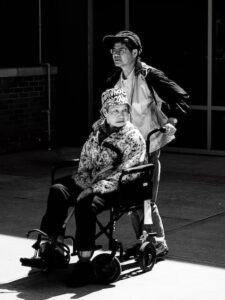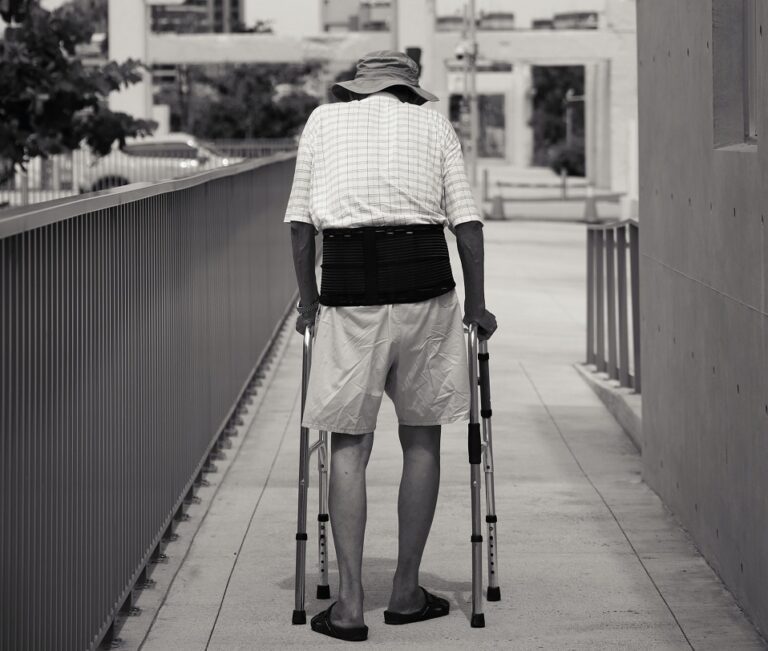Page Contents
As the global population ages, healthcare professionals must adapt to the unique needs of older adults. Among the numerous issues faced by this population, the “Geriatric Giants” stand out as a set of common, interrelated clinical conditions that significantly impact health and independence.
First introduced by Bernard Isaacs in 1965, these conditions (immobility, instability, incontinence, and impaired cognition) are central to geriatric care. In this article, we will delve into each of these giants, their causes, implications, and management strategies.

1. Immobility: The silent decline
Definition and causes
Immobility refers to a reduction in physical activity or the inability to move freely. It is often a consequence of conditions like:
Muscle weakness (sarcopenia)
Neurological disorders (e.g., stroke, Parkinson’s disease)
Prolonged bed rest or hospitalisation
Implications
Immobility leads to complications such as pressure ulcers, deep vein thrombosis, muscle atrophy, and social isolation. These effects can create a downward spiral, further limiting activity.
Condition management
Physical therapy
Strengthening exercises and mobility aids can help restore function.Environmental modifications
Removing tripping hazards and providing ergonomic furniture can encourage movement.Multidisciplinary care
Collaboration among physiotherapists, occupational therapists, and caregivers ensures comprehensive management.

2. Instability: The fall risk factor
Definition and causes
Instability refers to poor balance and an increased risk of falls. Contributing factors include:
Vestibular dysfunction
Visual impairments
Medication side effects (e.g., sedatives, antihypertensives)
Peripheral neuropathy
Implications
Falls are a leading cause of injury and hospitalization in the elderly. They often result in fractures, fear of falling, and loss of confidence.
Condition management
Fall prevention programs
Balance and strength training are crucial.Medication review
Adjusting medications that contribute to dizziness or hypotension.Assistive devices
Canes, walkers, and grab bars provide additional support.

3. Incontinence: The hidden burden
Definition and causes
Incontinence is the involuntary loss of bladder or bowel control. Common types include:
Urge incontinence (overactive bladder)
Stress incontinence (weakened pelvic floor muscles)
Overflow incontinence (incomplete bladder emptying)
Implications
Incontinence affects physical health through skin breakdown and urinary tract infections. Psychologically, it leads to embarrassment, social withdrawal, and reduced quality of life.
Condition management
Behavioral therapies
Bladder training and pelvic floor exercises (e.g., Kegel exercises).Medical interventions
Medications like anticholinergics or surgical options for severe cases.Lifestyle modifications
Dietary adjustments to avoid bladder irritants and regular toilet schedules.

4. Impaired cognition: The cognitive challenge
Definition and causes
Impaired cognition encompasses issues with memory, decision-making, and mental clarity. Common causes include:
Dementia: Alzheimer’s disease, vascular dementia
Delirium: Often acute and reversible, triggered by infections or medications
Depression: Frequently underdiagnosed in older adults
Implications
Cognitive decline affects daily functioning, caregiver burden, and long-term care needs. Behavioural changes can strain relationships and complicate medical care.
Condition management
Early diagnosis
Cognitive screening tools such as the Mini-Mental State Examination (MMSE) help identify issues.Non-pharmacological approaches
Cognitive stimulation therapy and structured routines.Medication
Cholinesterase inhibitors (e.g., donepezil) for certain types of dementia.Support systems
Caregiver education and respite services.

5. Iatrogenesis: The fifth giant
While not part of Isaacs’ original four, iatrogenesis (adverse effects caused by medical interventions) has become increasingly recognised as a significant issue in geriatrics. Examples include:
Polypharmacy leading to drug interactions
Hospital-acquired infections
Procedural complications
Condition management
Medication reconciliation
Regularly reviewing and rationalising prescriptions.Infection control measures
Hand hygiene and vaccination.Patient-centered care
Avoiding unnecessary procedures and tailoring treatments to individual needs.
6. Infection: The often overlooked threat
Definition and causes
Infection refers to the invasion and multiplication of harmful microorganisms in the body, leading to illness. Older adults are particularly vulnerable to infections due to:
Weakened immune system
Immunosenescence reduces the body’s ability to fight pathogens.Chronic illnesses
Conditions like diabetes and COPD increase susceptibility.Hospitalisation
Exposure to nosocomial infections.Common infections in the elderly
Pneumonia, urinary tract infections (UTIs), and skin infections.
Implications
Infections in older adults can lead to severe complications, including sepsis, delirium, and exacerbation of underlying conditions. They often present atypically, such as confusion or generalised weakness, delaying diagnosis.
Condition management
Early detection
Regular monitoring for signs of infection, especially in high-risk individuals.Vaccination
Influenza, pneumococcal, and shingles vaccines are vital preventive measures.Antibiotic stewardship
Ensuring appropriate use to prevent resistance.Hygiene measures
Handwashing, proper wound care, and infection control protocols in healthcare settings.
Integrating care for the geriatric giants
Addressing the Geriatric Giants requires a holistic, patient-centered approach. Key principles include:
Interdisciplinary collaboration
Involving geriatricians, nurses, therapists, and social workers.Comprehensive Geriatric Assessment (CGA)
A multidimensional evaluation to identify and manage medical, psychological, and functional issues.Preventive care
Regular screenings, health education, and early intervention.
Conclusion
The Geriatric Giants represent the core challenges of ageing. While these conditions are complex and often interrelated, proactive management can significantly improve outcomes. By focusing on prevention, early detection, and comprehensive care, healthcare professionals can help older adults maintain independence and dignity in their later years. As we strive for better eldercare, understanding and addressing these giants will remain central to the mission of geriatric medicine.
